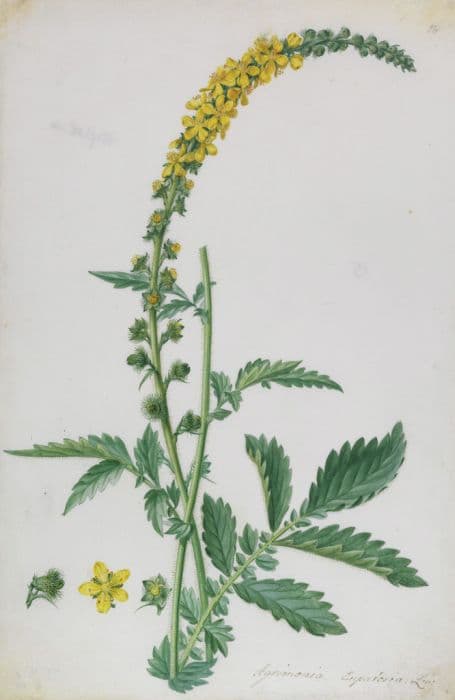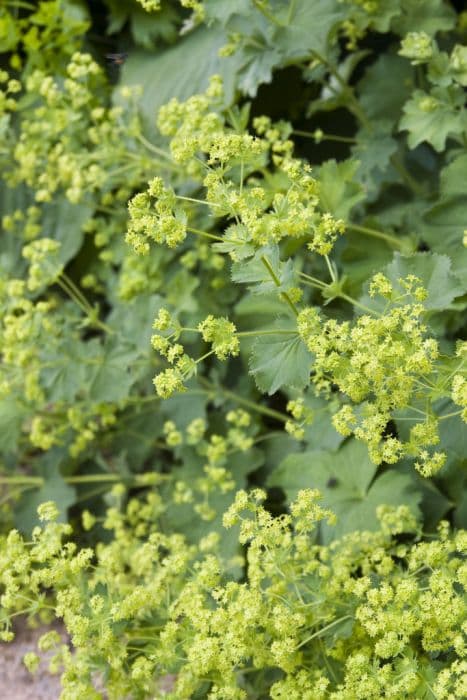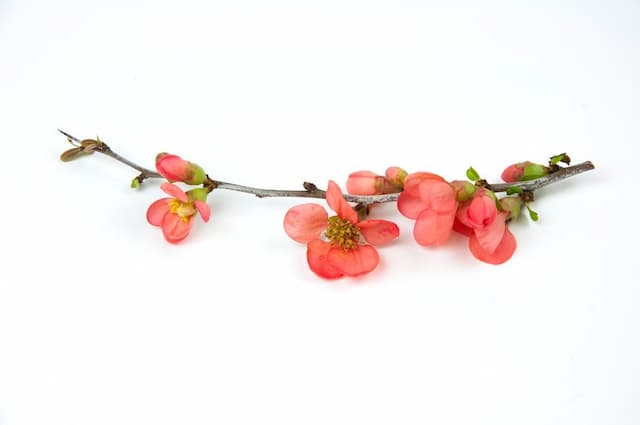Meadowsweet Filipendula ulmaria

ABOUT
The plant commonly known as meadowsweet boasts a lush, herbaceous character. Its stems are upright and reddish in color, supporting its many dark green leaves which have a unique appearance – they are sharply toothed, with a modest sheen and a pale underside that contrasts with their darker top. The plant is crowned by clusters of small, creamy white flowers that are arranged in elegant, fluffy sprays. These flowers emit a sweet, almond-like fragrance that perfumes the air around it, making meadowsweet a delightful addition to any garden or meadow setting. The blooms of meadowsweet are not only striking in their own right, but they also attract a variety of pollinators, playing a crucial role in the local ecosystem. Despite the omission of its specific dimensions, the plant’s physical presence is quite notable due to its distinctive foliage and attractive, fragrant flowers.
About this plant
 Names
NamesFamily
Rosaceae.
Synonyms
Meadowsweet, Mead Wort, Queen of the Meadow, Lady of the Meadow, Meadow Queen, Bride of the Meadow, Dollof, Meadsweet, Bridewort.
Common names
Spiraea ulmaria, Ulmaria pentapetala, Spiraea palustris, Ulmaria palustris, Filipendula denudata, Filipendula ulmaria var. denudata, Spiraea ulmaria var. denudata, Ulmaria filipendula Gilib.
 Toxicity
ToxicityTo humans
Meadowsweet has not been widely reported as a toxic plant to humans when used in appropriate amounts. Traditionally, it has been used for medicinal purposes for its anti-inflammatory and analgesic properties. However, like any plant, it can potentially cause adverse reactions in some individuals, particularly those who are allergic to aspirin, as it contains salicylates, the compounds from which aspirin was originally derived. Ingesting large quantities of meadowsweet could theoretically lead to salicylate toxicity, which can cause symptoms such as ringing in the ears (tinnitus), nausea, vomiting, dizziness, and rapid breathing. Those with asthma or an allergy to aspirin should avoid using meadowsweet. Prolonged use or overconsumption should be avoided to prevent potential side effects and toxicity.
To pets
Meadowsweet is also not typically known to be toxic to pets. However, as with humans, the salicylates present in the plant could potentially cause adverse effects if consumed in large amounts. Symptoms of salicylate toxicity in pets might mirror those in humans, experiencing issues such as gastrointestinal upset with vomiting and diarrhea, difficulty breathing, and altered mental states. Pet owners should exercise caution and prevent their animals from ingesting significant quantities of meadowsweet. If you suspect your pet has consumed a potentially toxic plant, it is always best to consult a veterinarian.
 Characteristics
CharacteristicsLife cycle
Perennials
Foliage type
Deciduous
Color of leaves
Green
Flower color
White
Height
4 feet (1.22 meters)
Spread
4 feet (1.22 meters)
Plant type
Herb
Hardiness zones
3
Native area
Europe
Benefits
 General Benefits
General Benefits- Wildlife Habitat: Offers shelter and food sources for a variety of insects and other wildlife.
- Erosion Control: Its root system helps stabilize soil and prevent erosion near water bodies.
- Aesthetic Appeal: Features attractive, frothy white flowers that enhance the visual appeal of gardens and natural areas.
- Traditional Crafts: The stems have historically been used for making small items like baskets.
- Ecological Diversity: Contributes to plant diversity in wetlands and riparian environments.
- Natural Sweetener: Historically, the flowers have been used to impart a sweet flavor in homemade wines and vinegars.
- Culinary Use: Young leaves have been used in salads or to flavor soups, though this is not a primary use of the plant.
- Garden Dynamics: Acts as a companion plant, potentially benefiting neighboring plants through its natural growth habits.
 Medical Properties
Medical Properties- Anti-inflammatory: Meadowsweet, commonly known as Filipendula ulmaria, contains compounds that may help reduce inflammation.
- Analgesic: It has properties that may alleviate pain, akin to the effects of aspirin.
- Antipyretic: This plant may aid in lowering fevers.
- Gastroprotective: Meadowsweet can offer protection to the digestive tract and help in maintaining its health.
- Diuretic: It may promote the production of urine, thereby supporting kidney function and fluid balance.
- Astringent: The astringent qualities of meadowsweet may help in toning the skin and mucous membranes.
 Air-purifying Qualities
Air-purifying QualitiesThis plant is not specifically known for air purifying qualities.
 Other Uses
Other Uses- Filipendula ulmaria, commonly known as meadowsweet, can be used as a natural fabric dye, producing a range of colors from black to beige depending on the mordant used.
- Meadowsweet is employed in cosmetic products for its pleasant aroma and is often found in natural perfumes and scented lotions.
- The flowers of the meadowsweet plant are sometimes added to homemade jams and jellies, imparting a subtle almond flavor.
- In beekeeping, meadowsweet can be planted near hives as it is attractive to bees and helps boost honey production with its nectar.
- Meadowsweet has been historically used as a strewing herb, scattered on floors to give rooms a fresh scent and repel pests.
- The plant is incorporated into potpourri mixes for its fragrance and decorative flowers that hold their shape when dried.
- Meadowsweet is sometimes used in the craft of basketry as a natural source of materials, where the stems are woven into the basket structure.
- Due to its aroma, dried meadowsweet flowers are used as a natural air freshener in cars and closets.
- Culinary enthusiasts use meadowsweet flowers to infuse syrups, which are then used to add flavor to cocktails and non-alcoholic beverages.
- In some traditions, meadowsweet is used as a symbol of love and is incorporated into wedding decorations and bridal bouquets.
Interesting Facts
 Feng Shui
Feng ShuiThe Meadowsweet is not used in Feng Shui practice.
 Zodiac Sign Compitability
Zodiac Sign CompitabilityThe Meadowsweet is not used in astrology practice.
 Plant Symbolism
Plant Symbolism- Peace and Tranquility: The soft, frothy white flowers of the meadowsweet plant often symbolize peace and a calm spirit, reflecting the way it gently sways with the summer breeze in its natural riparian habitat.
- Healing and Restoration: Historically used for its medicinal properties to alleviate pain and fevers, meadowsweet carries connotations of healing and restoring balance to the body.
- Courtship and Love: In folklore, meadowsweet was sometimes associated with love and relationships. Its pleasant fragrance made it a popular strewing herb in medieval times, used in ceremonies and to refresh indoor air, suggesting a connection to human warmth and affection.
- Protection: Meadowsweet was thought to have protective qualities in traditional lore. It was used to keep negative energies at bay, reflecting an attribute of spiritual safeguarding.
- Celebration: Due to its association with festivals in certain cultures, particularly in the Celtic beltane festivities, meadowsweet symbolizes joy, celebration, and the height of summer.
 Water
WaterThe common name of Filipendula ulmaria is meadowsweet. Meadowsweet should be watered deeply, allowing the soil to become moist but not waterlogged. It's best to water this plant once or twice a week, providing about 1 gallon of water each time during the growing season. Ensure the plant has sufficient drainage to prevent root rot. During the winter months, reduce watering frequency as the plant goes dormant and requires less moisture.
 Light
LightMeadowsweet thrives in full sun to partial shade. The ideal location would provide it with morning sunlight and some shade during the hot afternoon hours. Filtered sunlight throughout the day can also be beneficial, as it mimics the light conditions of its natural woodland edges and meadow habitats.
 Temperature
TemperatureMeadowsweet prefers temperate conditions and can tolerate temperatures between 45°F and 75°F, which are considered its ideal growing temperatures. It can withstand occasional dips below freezing, but prolonged exposure to temperatures below 20°F may be harmful to the plant.
 Pruning
PruningMeadowsweet should be pruned to remove spent flowers and encourage a second bloom. It's also important to cut back the plant in late fall or early winter to prepare it for dormancy. Pruning should be done annually, and the best time is after the main flowering period has ended.
 Cleaning
CleaningNot needed
 Soil
SoilMeadowsweet prefers moist, fertile soil with good drainage. The best soil mix for this plant includes garden loam, peat, and some sand to improve drainage. The soil pH should ideally be between 5.5 and 7.0.
 Repotting
RepottingMeadowsweet does not require frequent repotting and can often be left undisturbed for several years. Repotting may only be necessary if the plant has outgrown its current container, which typically occurs every 3-4 years.
 Humidity & Misting
Humidity & MistingMeadowsweet thrives in environments with moderate to high humidity levels. It does well in natural outdoor humidity but may require increased humidity if grown indoors, especially during dry winter months.
 Suitable locations
Suitable locationsIndoor
Keep in indirect light, maintain humidity, and use moist soil for Meadowsweet.
Outdoor
Meadowsweet thrives in full sun to part shade and moist conditions.
Hardiness zone
4-9 USDA
 Life cycle
Life cycleMeadowsweet (Filipendula ulmaria) begins its life cycle when its seeds germinate in moist, fertile soil, typically in spring. The seedlings emerge and develop into rosettes of pinnate leaves close to the ground. As the plant matures, it forms erect stems which can reach up to 2 meters in height and bear clusters of small, creamy-white flowers in early summer. After pollination by insects, the flowers produce small, spirally arranged achenes as fruits, which disperse to new locations, potentially growing into new plants. The plant is perennial, meaning it can survive through multiple seasons, with its foliage dying back to the root system each autumn before regrowing the following spring. Meadowsweet spreads both by seed and vegetatively through its creeping rhizomes, allowing it to form extensive colonies in suitable habitats.
 Propogation
PropogationPropogation time
Spring to summer
Propogation: The common name for Filipendula ulmaria is meadowsweet. Meadowsweet is typically propagated through division, which is a technique where the rootball of an established plant is split into several sections. The best time for propagation by division is typically in the spring or fall when the plant is not in active growth. To propagate meadowsweet using division, carefully dig up an established plant, taking care to preserve as much of the root system as possible. Then using a sharp spade or knife, divide the clump into smaller sections, each with some roots and shoots. These sections can then be immediately replanted in moist, well-drained soil, spaced about 2 feet (approximately 0.61 meters) apart to allow for spreading. Water the new plantings thoroughly to help establish them.









